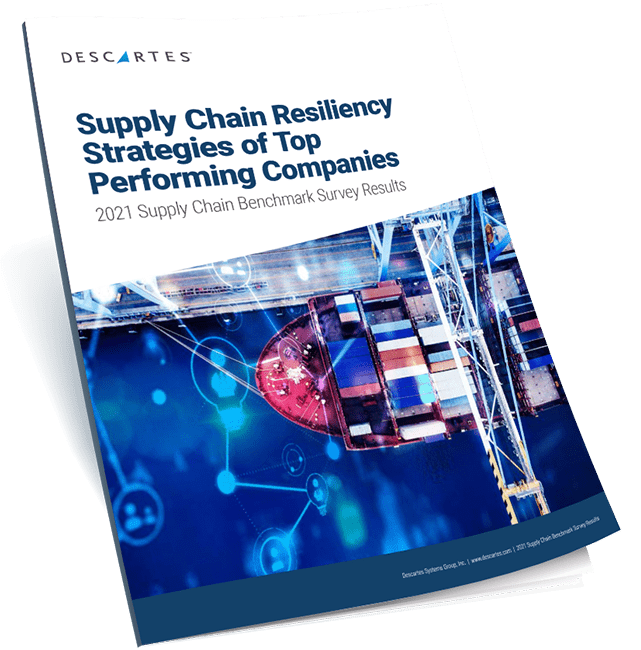The Global Shipping Crisis
The Global Logistics Shipping Crisis: Just like “Groundhog Day”
After looking at the logistics or economic metrics Descartes is tracking, you may think you are reliving the same day over and over. The data continues to highlight that there will be no break from the global logistics crisis any time soon. The global logistics challenge also has a local component—drivers—so we have added additional information to help provide greater insight in the issues that companies will face into 2022 and possibly beyond. Here’s where we stand as of mid-November.
In this Article...
- toc
Another Strong Month for U.S. Import Container Volume.
October was up versus September and October 2020 (see Figure #1). October is a longer month and not impacted by national holidays, unlike September. Overall, October 2021 was 3% higher than 2020 and 23% higher than 2019. By October 2020, the economy had fully adjusted and the peak holiday season was fully underway, so it is no surprise that 2021 did not have much growth. However, when comparing the last 12 rolling months versus 2019, U.S. container import volume is up 21% versus 2019. As we stated in October, the 2021 TEU volume should hover between 2.4M and 2.6M TEUs monthly through the end of the year, which continues to happen. Assuming there is no container import volume softness in early 2022, the peak season in the second half of 2022 will drown out any decline we might see until November and December of 2022.
Figure #1: U.S. Container Import Volume Year-over-Year Comparison

LA Gets the Press – But It is Not Alone
The extended run of high container import volumes and the impact of port wait times has been highly documented by industry and national publications. Wait time at the Port of Los Angeles is down very slightly in October at 14.21 days versus 14.51 days in September and 15.31 days in August. However, wait times in October at East Coast ports are also extensive with the Ports of New York/New Jersey at 8.41 days and the Port of Savannah at 9.71 days.
Major Carriers and Logistics Service Providers (LSPs) Announced Record Financial Performance.
Equally important, they’ve stated that they forecast strong demand for their services well into 2022. There has been a lot of press focus on high profile shippers chartering their own vessels, but most are relatively small and provide little capacity increase to alleviate the current situation.
Inventory levels continue to lag and next year’s International Longshore and Warehouse Union (ILWU) contract will put more pressure on shipping volumes early in 2022.
The retail inventory to sales ratio improved slightly but is still well behind pre-pandemic levels (see Figure #2). This should be evident to everyone going to just about any kind of store. Retailers have stated they want to carry more inventory than currently to improve sales and customer experience. On July 1st, the ILWU contract will expire, and, with a history of contentious negotiations, importers will want more inventory to mitigate the impact of any work stoppages. The combination of inventory “catch up” and contract risk mitigation will most likely eliminate the traditional lower container import volumes over the winter and not allow the global capacity shortage and asset imbalance to correct itself before peak season arrives in 2022.
Figure #2: FRED Retail Inventory to Sales Ratio

The Word is Fully Out On the “Stuff Economy”
With almost every publication now covering it, there doesn’t need to be detailed explanation about how consumers are spending more on goods because they do not have the ability to spend on services. However, Stuff Economy metrics need to be tracked (see Figure #3) because goods purchases are a significant factor driving container import volumes. Until services like international travel pick up, there will not be significant places for consumers to spend beyond goods. As a reminder, the ratio of personal consumption of goods to services has increased 8% since the start of the pandemic.
Figure #3: Personal Consumption Metrics

The Driver Shortage May Eclipse Other Issues
The shortage of drivers affects global and local trade. Whether it’s getting goods out of ports to last-mile deliveries, there are not enough drivers and the situation appears to be getting worse. The data tells the story:
- Current U.S. driver shortage stands at 80,000 and is projected to be 160,000 in 20302
- The overall unemployment rate declined to 4.6% in October
- October’s unemployment numbers were good overall and 54,000 jobs in transportation and warehousing were created, but only 8,000 were drivers3
To access other articles that track port congestion monthly, visit the
Global Shipping Resource Center
White Papers
Survey Uncovers Supply Chain Strategies of Top Performing Companies
Surviving Peak Season and Beyond: The Essential Guide to Supply Chain Resiliency

Executive Vice President of Industry and Services
Descartes Systems Group
Global Trade Intelligence Key to Minimize Supply Chain Delays

Descartes recently conducted a benchmark survey and uncovered the supply chain resiliency strategies of top-performing companies.
Get your copy of the survey results and find out key steps you can take to reduce risk and create a more resilient supply chain
Don’t Forget About the Pandemic
Given how much freight is moving today, supply chains and supply chain workers have been one of the heroes of the pandemic. However, even the heroes cannot overcome the massive COVID-19 outbreak. We have to take into account that a large part of the world’s population is not fully vaccinated.
Vietnam is a good example of what can happen. Vietnam did very well in 2020, but the country was hit hard with outbreaks and subsequent lockdowns in the summer of 2021. As a result, exports collapsed in some industries such as furniture where Vietnam had been considered a rising global star (see Figure #4).
Figure #4: Vietnam Maritime Furniture Exports to the United States

What About Supply Chain Improvements?
There is significant investment in a number of areas in the supply chain to help alleviate the current bottlenecks. For example, there are 619 container ships under contract for construction4 and 477 million square feet5 of warehouse space underway. These will come online in the next 1-5 years. The U.S. Infrastructure Investment and Jobs Act will provide money to help alleviate port congestion, but the improvements could be 5+ years away from making a difference.
Don’t treat this like a short-term problem or everyday you’ll find yourself waking up to Sonny and Cher.
There is nothing in the logistics and economic data that indicates the global logistics crisis is a short-term problem that can be waited out. Risk mitigation tactics continue to need to be employed, but supply chain strategies need to be adjusted as well. Descartes will highlight key Descartes Datamyne™, U.S. government and industry data that provides insight into the global shipping crisis. Our recommendations remain the same with an additional one on resources:
Short-term:
- Shipping capacity constrained? Rationalize SKUs to ship higher velocity and margin goods to maximize profitability.
- Focus on keeping the supply chain resources you have, especially drivers. The old adage “a bird in the hand is worth more than 2 in the bush” definitely applies here. Building trips to reduce stress and improve quality of life to retain drivers is now as or more important than wage increases.
Near-term:
- Shift the movement of goods to less congested transportation lanes to improve supply chain velocity and reliability. Total transit time is important, but so is supply chain predictability. Evaluate alternative transportation lanes into the U.S. including entry through northern and southern borders and inland ports.
Long-term:
- Evaluate supplier and factory location density to mitigate reliance on over-taxed trade lanes. Density creates economy of scale, but also risk, and the pandemic and subsequent logistics capacity crisis highlight the downside.
Notes
How Descartes Can Help
Descartes Datamyne delivers business intelligence with comprehensive, accurate, up-to-date, import and export information.
Our multinational trade data assets can be used to trace global supply chains and our bill-of-lading trade data – with cross-references to company profiles and customs information – can help businesses identify and qualify new sources. Ask us for a free, no obligation demonstration of our data on a product or trade commodity of your choosing – and keep the custom research we create with our compliments.
